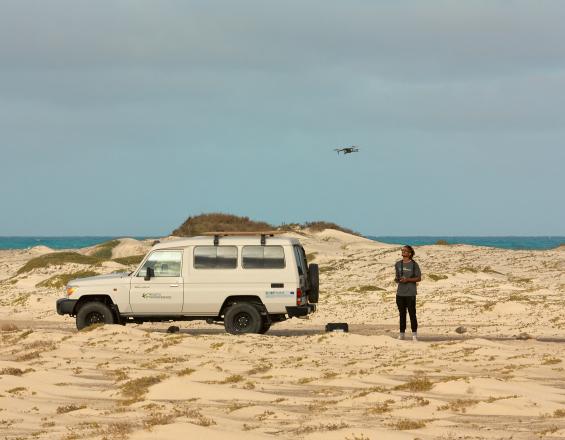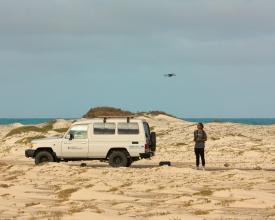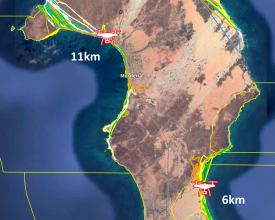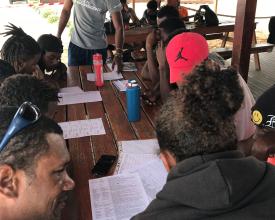
Les technologies de pointe au service des efforts de coopération : l'utilisation de patrouilles de drones pour lutter efficacement contre le braconnage des tortues caouannes

Le Cabo Verde est probablement le plus grand site de nidification au monde pour les tortues caouannes, classées comme menacées sur la liste rouge de l'UICN, mais de nombreuses menaces compromettent leur survie. L'une des principales menaces pour les tortues adultes de l'île de Sal est la chasse aux femelles nicheuses, qui a augmenté pendant et après la pandémie de COVID-19. En réponse, des patrouilles à pied et par drone ont été mises en place dans trois ZMP et, lorsque les conditions de vol étaient favorables, les baies accessibles d'une quatrième ZMP ont également été patrouillées. Ces patrouilles ont été renforcées par l'achat de drones plus perfectionnés dotés d'une imagerie infrarouge. L'emploi local, ciblé sur les communautés voisines des AMP, et les initiatives communautaires ont également été des éléments essentiels de la solution. En conséquence, les niveaux de braconnage ont été considérablement réduits dans toutes les AMP ciblées, les partenariats communautaires ont été renforcés et la protection globale au sein des AMP a été renforcée. Ce projet a été soutenu par l'Union européenne et l'Organisation des États ACP dans le cadre du programme BIOPAMA.
Contexte
Défis à relever
L'augmentation du braconnage dans les grandes zones de nidification en réponse à la pandémie de COVID-19 a été traitée directement par l'utilisation de patrouilles de drones utilisant une technologie avancée avec des capacités infrarouges, permettant la détection et la réponse à l'activité de braconnage. Les patrouilles à pied ont également été renforcées dans l'AMP la plus touchée de Murdeira, avec l'aide quotidienne de l'armée. L'emploi de cette équipe de patrouille était destiné à la communauté voisine, considérée comme contribuant à l'augmentation du braconnage, afin de sensibiliser la population locale. D'autres stratégies de sensibilisation ont été mises en œuvre avec le renforcement du partenariat communautaire avec les associations locales de pêcheurs, qui ont effectué des patrouilles volontaires dans leurs zones locales.
Emplacement
Traiter
Résumé du processus
Afin de mettre en œuvre des patrouilles efficaces, une formation a été dispensée à l'ensemble des employés et des parties prenantes sur lesquels on s'appuierait tout au long de la saison de nidification. Grâce à une formation continue et à une meilleure compréhension des pratiques de conservation, l'équipe de patrouille a acquis les compétences et les connaissances qui lui ont permis d'être plus satisfaite de son travail et, par conséquent, de faire preuve de plus d'empathie dans la conservation de cette population de tortues. Des patrouilles à pied efficaces, assistées par l'armée, ont été renforcées par l'utilisation de technologies avancées et, en cas de détection d'infractions dans les zones ciblées, il a été fait appel à la police nationale pour intervenir. L'accessibilité de certaines plages de nidification étant limitée, il n'a pas toujours été possible d'arrêter les personnes concernées, malgré la capacité de la technologie de pointe à détecter les infractions. C'est pourquoi la combinaison de cette technologie de pointe, qui a un effet dissuasif, et de la sensibilisation continue de la population locale constitue une solution efficace à long terme pour la conservation d'une population de tortues menacée d'extinction.
Blocs de construction
Utilisation de technologies avancées
L'utilisation de la technologie avancée des drones avec imagerie thermique et infrarouge permet de mieux saisir les infractions dans les zones ciblées, ainsi que de parcourir de plus grandes distances pendant plus longtemps. Cette technologie permet de couvrir de plus grandes distances avec moins de ressources, par exemple, des plages de nidification plus isolées qui nécessiteraient une équipe plus importante pour des raisons de sécurité, ou une logistique plus complexe pour localiser les équipes sur ces plages.
Facteurs favorables
Une formation intensive ou le recrutement d'une ou plusieurs personnes qualifiées pour utiliser cette technologie de pointe est indispensable. Dans le cas présent, les pilotes de drone avaient déjà une expérience des vols de nuit utilisant l'imagerie thermique et ont donc pu rapidement apprendre à utiliser et à comprendre la nouvelle imagerie des caméras infrarouges. Il est également essentiel que les personnes aient une connaissance de la zone cible et une expérience de la navigation dans cette zone, à la fois par drone et par véhicule.
Leçon apprise
La technologie de pointe est utile en soi, mais elle est beaucoup plus efficace lorsqu'elle est associée à des techniques conservatrices. Dans le cas présent, si la patrouille par drone a permis de couvrir rapidement une vaste zone, elle n'a pas été en mesure de voler pendant toute la durée de la période (toute la nuit). Par conséquent, lorsqu'elle est combinée à des patrouilles à pied, elle améliore la couverture de la ZMP et permet une plus grande protection à l'intérieur de la ZMP et des plages isolées qui l'entourent. Il est également important de considérer que si le drone pouvait atteindre rapidement et facilement les zones isolées, lorsque des infractions étaient découvertes, la réponse des personnes appropriées (patrouilles à pied ou autorités) était beaucoup plus lente, ce qui permettait aux braconniers d'échapper à l'arrestation. Bien qu'il soit efficace pour dissuader le braconnage, ce qui était un avantage dans ce cas, pour d'autres contextes, cela peut être un facteur important dans la planification de la stratégie.
Engagement des parties prenantes et sensibilisation de la population locale
La collaboration avec les autorités locales (mairie, armée et police nationale) a nécessité des réunions stratégiques préalables et la formation de leur personnel. La formation a préparé le personnel militaire à participer aux patrouilles nocturnes tout au long de la saison, assurant ainsi la sécurité de nos employés tout en les sensibilisant aux pratiques de conservation. Grâce à cette expérience et à cette sensibilisation, il est courant de recevoir des demandes d'emploi de la part de militaires après la fin de leur service. Les réunions avec la mairie et la police nationale permettent de partager la stratégie de conservation et d'apporter une réponse plus efficace aux infractions commises pendant la saison. Bien qu'il s'agisse d'un événement peu courant, même ces rencontres peu fréquentes ont permis d'engager et de sensibiliser les officiers de police et les techniciens du conseil. L'engagement communautaire par le biais d'initiatives telles que le partenariat avec les associations locales de pêcheurs a permis de sensibiliser une communauté clé aux pratiques de conservation. Pour ce faire, des mesures incitatives ont été prises en faveur de l'association (don de matériel, par exemple) en échange de patrouilles bénévoles sur une plage voisine de l'AMP de Costa Fragata.
Facteurs favorables
Contact et formation avec les autorités compétentes : mairie, armée, police nationale. Un lien établi avec les groupes communautaires ciblés par le biais de partenariats/projets antérieurs ou un porte-parole au sein de cette communauté qui peut l'encourager à prendre part à de telles initiatives. Une communication et un suivi continus avec toutes les parties prenantes tout au long de la mise en œuvre du projet et après, par le biais d'autres moyens de sensibilisation.
Leçon apprise
L'emploi direct n'est pas nécessairement la meilleure et la seule option pour s'engager avec la communauté locale. Une présence constante avant, pendant et après la mise en œuvre du projet est la clé d'un partenariat solide ou d'un effet de sensibilisation au sein de la communauté et des parties prenantes. Comprendre les motivations ou les exigences des communautés ciblées et des parties prenantes peut permettre d'établir un partenariat plus solide et plus durable. Plus les connaissances et les compétences sont partagées en vue de la mise en œuvre du projet, plus la mise en œuvre de la stratégie est efficace. Par exemple, dans ce cas, la formation des militaires avant le début des patrouilles a permis d'observer un plus grand niveau de participation et d'intérêt de la part des soldats.
Formation
Tous les employés ont reçu une formation théorique et pratique sur les pratiques de conservation des tortues de mer avant le début des patrouilles à pied et en drone. La formation portait sur la biologie des tortues de mer, les protocoles de patrouille et le marquage des tortues, suivie d'une formation pratique sur l'utilisation du GPS, l'identification des traces, le marquage des tortues, la relocalisation des nids et l'excavation. Une formation pratique continue a été dispensée tout au long de la saison au cours de patrouilles adaptées à l'expérience de l'employé. Les personnes occupant des postes tels que celui de chef d'équipe ont également bénéficié d'un soutien et d'une formation continus afin d'améliorer leurs compétences en matière de leadership.
Facteurs favorables
La formation a été menée par des professionnels ayant de nombreuses années d'expérience dans le domaine de la conservation des tortues. L'efficacité de la formation est due à la conception et à la stratégie mises en œuvre grâce à l'expérience de l'équipe de coordination. La disponibilité de ces professionnels pour couvrir tous les domaines de la mise en œuvre a permis de mettre la formation continue à la disposition de toute l'équipe.
Leçon apprise
La mise en œuvre de la formation nécessite des professionnels ayant la capacité et l'aptitude à former efficacement des employés nouveaux et expérimentés. La clé pour pouvoir former efficacement l'ensemble de l'équipe était d'avoir une combinaison de nouveaux employés et d'employés expérimentés, pour permettre au projet (dans ce cas, les patrouilles) d'être mis en œuvre efficacement tout en continuant la formation. La capacité à former une grande équipe avec peu de professionnels est entravée par un grand nombre de nouvelles recrues.
Impacts
La population de Sal en général a bénéficié de ce projet grâce à une meilleure protection de la population de caouannes. Les activités d'éco-tourisme autour de cette espèce ont été une attraction permanente qui est connue pour générer plus de 500 000 € de revenus par an. Ce projet a bénéficié directement à 11 jeunes (7 gardes forestiers, 2 pilotes de drones et 2 assistants) en les employant pendant la saison de nidification, ce qui a permis à leurs familles de bénéficier d'un revenu supplémentaire. Les associations locales de pêcheurs ont reçu une formation complémentaire et ont effectué des patrouilles nocturnes sur une plage bordant l'une des AMP ciblées. Les autorités chargées de l'application de la loi se sont engagées et ont participé aux patrouilles anti-braconnage, avec une formation dispensée à plus de 120 nouveaux soldats qui ont rejoint les patrouilles quotidiennement. Renforcement de la protection au sein des AMP ; le braconnage a été réduit de 84 % dans l'AMP de Costa Fragata, de 81 % dans l'AMP de Murdeira et de 45 % dans l'AMP de Ponta Sino. Au total, 551 vols de drones ont été effectués, soit plus de 123 heures de vol, couvrant quatre AMP.
Bénéficiaires
Délégation du ministère de l'agriculture et de l'environnement
La police nationale
L'armée
La mairie
Les associations de pêcheurs
Les employés locaux du Projeto Biodiversidade
Guides touristiques locaux (excursions d'observation des tortues)
La population de Sal en général
Objectifs de développement durable
Histoire
Pendant et après l'épidémie de COVID-19, le braconnage dans l'AMP de Murdeira a considérablement augmenté, en partie à cause de la communauté voisine qui avait un taux de chômage élevé et des conditions de vie médiocres. En réponse, en 2021, une initiative de volontariat a été introduite et, en 2022, elle a été renforcée en ciblant le recrutement de ces volontaires. L'un des candidats était un braconnier connu au sein de la communauté, mais grâce à un contact direct avec le projet, il est devenu le principal point de contact pour impliquer davantage la communauté. Il s'est porté volontaire pour les patrouilles en 2021 et a participé à d'autres activités de sensibilisation de la communauté en dehors de la saison des tortues et a donc été employé en 2022. Tout au long de son emploi, il a changé d'attitude envers les tortues, a acquis des compétences en matière de conservation des tortues, a fait preuve d'engagement envers la préservation des tortues et s'est assuré un emploi pour les saisons de nidification à venir.


